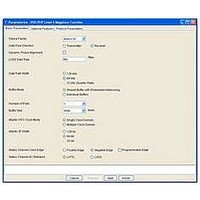IP-POSPHY4 Altera, IP-POSPHY4 Datasheet - Page 49

IP-POSPHY4
Manufacturer Part Number
IP-POSPHY4
Description
IP CORE - POS-PHY Level 4 SPI 4.2 Interface
Manufacturer
Altera
Type
MegaCorer
Datasheet
1.IP-POSPHY4.pdf
(144 pages)
Specifications of IP-POSPHY4
Software Application
IP CORE, Interface And Protocols, COMMUNICATION
Supported Families
Arria GX, Cyclone, HardCopy, Stratix
Core Architecture
FPGA
Core Sub-architecture
Arria, Cyclone, Stratix
Rohs Compliant
NA
Function
POS-PHY Level 4 Interface, Link-Layer/PHY Layer
License
Initial License
Lead Free Status / RoHS Status
na
Lead Free Status / RoHS Status
na
- Current page: 49 of 144
- Download datasheet (3Mb)
Chapter 4: Functional Description—Receiver
Block Description
Figure 4–3. Receiver External Status Timing Diagram
Notes to
(1) The external status address does not have to be incrementing. Any value within calendar length can be provided at any time.
(2) The calendar status after the last clock cycle shown has: port 0 = 2’b00, port 1 = 2’b10, port 2 = 2’b01, and port 3 = 2’b00.
December 2010 Altera Corporation
Figure
4–3:
1
ctl_ry_extstat_adr
ctl_ry_extstat_val
ctl_ry_extstat
rxsys_clk
Due to the round trip latency of the status channel, especially at high calendar
lengths, the hysteresis between the AE and AF values (in addition to the possibility of
the override capabilities listed above) may be such that a transition from starving to
satisfied (and vice versa) can occur. In the event that a transmitting device does not
allow these types of transitions (require hungry state to be observed between starving
and satisfied), you should ensure that the difference between AE and AF values is
greater than the hysteresis between the thresholds.
The external status address you provide does not have to be incrementing or have any
set sequence. You can provide any address value, at any time. If the external address
provided is for an unprovisioned port, the value is written into the internal RAM at
that address, but the internal status block never reads from that location.
The status hold block reads the contents of the memory where you have stored the
status of the external FIFO buffer(s).
The status calculator block compares the Atlantic FIFO buffer fill levels to the AE and
AF values for the requested port. In the shared buffer with embedded addressing
mode, because there is a single Atlantic FIFO buffer, the status for any port is
calculated according to the single level as opposed to a per-port basis.
The outgoing status of all ports is forced to satisfied ,if the datapath clock-crossing
buffer or Atlantic buffer overflows.
The FIFO buffer status of each port is encoded in 2 bits (refer to
transmitted synchronous to the rsclk.
Table 4–1. Status Channel Field Descriptions (Part 1 of 2)
1
1
0
MSB
1
0
1
LSB
2'b00
8'd0
Reserved for framing
SATISFIED—FIFO buffer is almost full. No new credits should be granted in the far
end scheduler.
HUNGRY—FIFO buffer is at a midpoint. MaxBurst2 credits should be granted in the
far end scheduler.
2'b00
8'd0
2'b00
8'd0
2'b00
8'd1
2'b01
8'd1
2'bxx
8'd0
2'bxx
Description
8'd0
2'bxx
8'd0
POS-PHY Level 4 MegaCore Function User Guide
2'b01
8'd2
2'b00
8'd3
Table
2'b10
8'd1
4–1) and is
4–9
Related parts for IP-POSPHY4
Image
Part Number
Description
Manufacturer
Datasheet
Request
R

Part Number:
Description:
IP CORE Renewal Of IP-POSPHY4
Manufacturer:
Altera
Datasheet:

Part Number:
Description:
IP Thermal Transfer Printer With Peel/Present Option
Manufacturer:
BRADY

Part Number:
Description:
CYCLONE II STARTER KIT EP2C20N
Manufacturer:
Altera
Datasheet:

Part Number:
Description:
CPLD, EP610 Family, ECMOS Process, 300 Gates, 16 Macro Cells, 16 Reg., 16 User I/Os, 5V Supply, 35 Speed Grade, 24DIP
Manufacturer:
Altera Corporation
Datasheet:

Part Number:
Description:
CPLD, EP610 Family, ECMOS Process, 300 Gates, 16 Macro Cells, 16 Reg., 16 User I/Os, 5V Supply, 15 Speed Grade, 24DIP
Manufacturer:
Altera Corporation
Datasheet:

Part Number:
Description:
Manufacturer:
Altera Corporation
Datasheet:

Part Number:
Description:
CPLD, EP610 Family, ECMOS Process, 300 Gates, 16 Macro Cells, 16 Reg., 16 User I/Os, 5V Supply, 30 Speed Grade, 24DIP
Manufacturer:
Altera Corporation
Datasheet:

Part Number:
Description:
High-performance, low-power erasable programmable logic devices with 8 macrocells, 10ns
Manufacturer:
Altera Corporation
Datasheet:

Part Number:
Description:
High-performance, low-power erasable programmable logic devices with 8 macrocells, 7ns
Manufacturer:
Altera Corporation
Datasheet:

Part Number:
Description:
Classic EPLD
Manufacturer:
Altera Corporation
Datasheet:

Part Number:
Description:
High-performance, low-power erasable programmable logic devices with 8 macrocells, 10ns
Manufacturer:
Altera Corporation
Datasheet:

Part Number:
Description:
Manufacturer:
Altera Corporation
Datasheet:

Part Number:
Description:
Manufacturer:
Altera Corporation
Datasheet:











